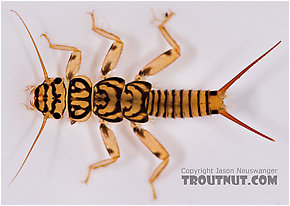Blog & Latest Updates
Fly Fishing Articles
Insects by Common Name


> > Probably Agnetina capitata
The Specimen
The Discussion
| GONZO | October 4th, 2006, 12:58 pm | |
Site Editor "Bear Swamp," PAPosts: 1681 | The row of spinules across the back of the head in combination with the presence of anal gills indicates that Agnetina is the likely genus; and the dorsal pattern appears to be classic capitata. | |
| Troutnut | October 4th, 2006, 1:00 pm | |
Administrator Bellevue, WAPosts: 2737 | Thanks. I've moved it to that species. | |
| Jason Neuswanger, Ph.D. Troutnut and salmonid ecologist | ||
| MattyL | July 2nd, 2008, 7:15 am | |
| Clifton Park, NY Posts: 1 | Just to add to Gonzo's assessment of characteristics, A. capitata is identified most definitively by looking at the dark pigment on tergum 10 as well as the head pattern. With this species, the pigment band on tergum 10 is uninterrupted (though it narrows quite a bit). The head "M line" is nearly lateral, as apposed to A. flavescens, for example, which really looks like an M with posterolaterally directed arms. | |
| -Matt | ||
| Jmd123 | March 23rd, 2011, 10:36 am | |
| Oscoda, MI Posts: 2611 | What a beautiful creature! Jason, did you collect this one? If so, was the leg missing when you collected it? Just curious. Jonathon | |
| No matter how big the one you just caught is, there's always a bigger one out there somewhere... | ||
| Troutnut | March 23rd, 2011, 10:41 am | |
Administrator Bellevue, WAPosts: 2737 | Yes, I collected it. I don't go pulling legs off my bugs at random, so the leg must have been missing when I found it in my sample tub. However, I sample with a kick-net, which is kind of a rough process for the bugs, so it could have been lost during that. I've also had bugs lose limbs to predators in my bucket/tub, but that's unlikely for a stonefly this size. | |
| Jason Neuswanger, Ph.D. Troutnut and salmonid ecologist | ||
| Jmd123 | March 23rd, 2011, 12:58 pm | |
| Oscoda, MI Posts: 2611 | We handled our bugs pretty roughly during our last project (oil-polluted streams in north Toledo) and I am surprised that more of them didn't end up being damaged. The vast majority of them were perfectly intact, even after we had to subsample and thus give them another round of rough handling. Perhaps attacked by a crayfish or small fish? Or a fight with another stonefly nymph?? Crayfish will go after each other pretty good and tear off limbs. Again, what a beautiful insect. It makes me glad that I went into entomology. Too many people miss the wonders of the natural world which is all around them, sometime in quite tiny form. A good microscope helps. Gotta take time to "smell the roses". Jonathon | |
| No matter how big the one you just caught is, there's always a bigger one out there somewhere... | ||
Quick Reply
You have to be logged in to post on the forum. It's this easy:
Related Discussions
| Title | Replies | Last Reply |
| I. hansoni In Isogenoides hansoni Stonefly Nymph by GONZO | 0 | |
| Re: I need your help to get some specimens of Caecidotea (Freshwater isopods). In General Discussion by Leonardo | 4 | Jun 1, 2016 by Crepuscular |
| Re: Indiana stream survey, Phase II (8 more) In the Photography Board by Jmd123 | 1 | Jun 3, 2021 by Partsman |
| Re: Seinne material In General Discussion by Aaron7_8 | 8 | Jan 17, 2009 by CaseyP |
| Re: What's this? In the Identify This! Board by Sglidster | 2 | Feb 22, 2012 by Konchu |
| Re: The Xerces Society??? In General Discussion by Oldredbarn | 3 | Oct 3, 2009 by Oldredbarn |
| Moved to Agnetina capitata In Agnetina capitata Stonefly Nymph by Entoman | 0 | |
| Agnetina In Agnetina capitata Stonefly Adult by GONZO | 0 | |
| Re: Unidentified Colorado Front Range Nymphs. In the Identify This! Board by DangerAF1 | 2 | Apr 20, 2020 by DangerAF1 |
| Re: Probably Acroneuria lycorias In Acroneuria abnormis Stonefly Nymph by GONZO | 1 | Oct 28, 2008 by GONZO |
Troutnut.com is copyright © 2004-2024 Jason
Neuswanger (email Jason). See my FAQ for information about use of my images.
 privacy policy
privacy policy



